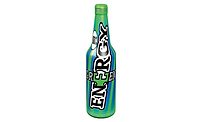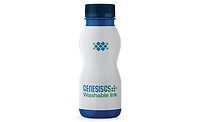Specialty inks, coatings create memorable first impression
Inks, coatings and brand design differentiate brands

Along with a terrific design, specialty inks such as thermochromic, photochromic or glow-in-the-dark will increase consumers’ purchase intent by at least 30%, a CTI consumer survey states.
(Image courtesy of Chromatic Technologies Inc.)
The catchphrase “you never get a second chance to make a first impression,” dates back to 1966 print ads for men’s suits. In many cases, an impression is made — good or bad — within the first 30 seconds of meeting someone. The same is true when it comes to capturing consumers’ attention as they scan crowded store shelves or shop online. Inks and coatings can help to create “theatre in the hand” while playing a key role in differentiating brands.
“We want the consumer to say, ‘Wow’ when a package changes color to confirm the beverage is icy cold, or an image or code appears in sunlight or the dark,” explains Patrick Edson, chief marketing officer at Chromatic Technologies Inc. (CTI). “When this is done well, brands drive increased purchase intent and secure additional retail support.”
Because sustainability is part of the vernacular, the trend has rubbed off on the use of specialty inks. The Colorado Springs, Colo.-based company has developed turbo colors that show brighter colors with less inks, saving money for companies, Edson says.

Image courtesy of INX International Ink Co.
“CTI is also the first company to offer thermochromic, glow-in-the-dark and photochromic in solvent ink formats, and we now offer hundreds of different color options,” he explains.
Jason Galley, senior director of sustainability, innovation and business development for Ball Aerosol Packaging at Ball Corp., Denver, notes that innovative coatings and inks on the outside of aluminum beverage bottles are key to capturing the attention of consumers.
Inks, along with creative, striking designs, can help differentiate brands. Ball Corp. offers its proprietary Eyeris, a high-definition printing technique that is designed for high impact. “It creates highly detailed and realistic graphics that bring a brand’s essence to life, so that when a consumer is browsing the aisles of their local supermarket, the design will stand out on the shelf,” Galley explains.
Protection with a pop of color
In the case of metal packaging for ready-to-drink (RTD) craft beers, canned cocktails, carbonated soft drinks or canned wines, inks are applied to the entire surface of the can followed by the application of clear coatings to protect the package from damage, explains Alex Folloso, director of metal decorating technology at INX International Ink Co., Schaumburg, Ill.
Interior coats on cans have dual functions: “to protect the liquid content from being adulterated by the can, and to prevent the beverage from damaging the can,” Folloso says.
Similarly, Ball Corp.’s Galley points out that the inside coating acts as a barrier between the aluminum and the beverage.
“The purpose of coatings is to extend product shelf life, and to ensure that the quality and taste of the product remain as intended, and Ball continues to work proactively with our coatings suppliers and customers to evaluate and improve next-generation coatings,” Galley says.

Images courtesy of Ball Corp.
Technological advances shine through
In addition to specialized printing techniques that figuratively help aluminum cans shine, one company is establishing a gold standard for dairy brands to protect and preserve its nutrient-rich contents.
A leader in light protection technology, Noluma International LLC, Wilmington, Del., uses its state-of-the-art patented technology to shield dairy’s nutrients and taste from deterioration from fluorescent and LED lighting, the company said in a statement. This ensures that the product inside has the quality freshness, nutritional elements, potency and sensory qualities promised on the label.
Although it does not sell packaging or packaging materials, the Noluma logo on the carton certifies that the packaging offers total light block, which not only protects the content’s nutrients and taste, but can often extend shelf life, it says.
When it comes to primary packages, however, specialty inks don’t differ that much from conventional inks, CTI’s Edson notes.
“Specialty inks print similar to conventional inks, but many of our inks are printed in clear or translucent colors and the printer needs to confirm inks are registered properly,” he says. “In this case, the inks are coupled with a fluorescent taggant, so they are visible in a vision system.
“CTI is the only ink company that sells thermochromic and photochromic inks for cans,” he continues. “Our inks use a high-velocity ink technology that has smaller particle sizes so our inks can print at 2,000 cans per minute. Our job is to make sure our inks print at same speeds as conventional ink so customers don’t have to slow down their can lines. … Coors Light, Smirnoff Ice Red, White & Berry, and Coke have done great things with our thermochromic ink capabilities.”
INX’s Folloso also notes that inks and coating for beer and beverage cans are designed to withstand the high-speed print process.
“Can line speeds are anywhere between 1,600 to 2,200 cans per minute (CPM) per line. Over the last few years, line-speeds are now pushing over 2,200 CPM. Inks and coatings are expected to perform the same at all speeds,” he says.
Typically inks are applied to cans through the dry offset print process, which requires a separate label for each color. “With offset, each color for a label is applied to a plate. The print plate, which has the image for that specific label, transfers the ink to a blanket,” Folloso explains. “The blanket then transfers the image to the can. An exterior coating is immediately applied on top of the ink, and both the ink and coating are cured.”
For products that are not aluminum-based, lithographic, flexographic or gravure processes are used for printing labels and primary packages.
The same is not true in the can-making industry, Folloso stresses. “The primary method of printing beer and beverage cans is dry offset. For food cans, the label is printed directly to the can by lithographic application.
“INX offers the AP Series inks for 2-piece beverage cans and AP LoVOC is our workhorse system for the majority of can labels,” he continues. “Other products include inks specific for retort applications or inks that will provide a tactile/texture effect. Monster, Coca Cola, Pepsi, Red Bull and Miller Coors are some examples of brands that have used our products.”
Sustainability and regulatory issues continue to push demands on ink suppliers, experts note. In line with this trend, CTI’s Edson says that it sells formulas that use 50 percent less ink than 10 years ago. Yet, these BPA-free inks deliver the same amount of eye-popping color, he adds.
INX recently introduced EcoCan (www.inxeconcan.com). Folloso notes, “It’s the industry’s first and only eco-friendly metal decorating ink to receive a Gold Level Material Health Certificate from the Cradle to Cradle Products Innovation Institute, in collaboration with the Environmental Protection Encouragement Agency (EPEA).”
Looking for a reprint of this article?
From high-res PDFs to custom plaques, order your copy today!






